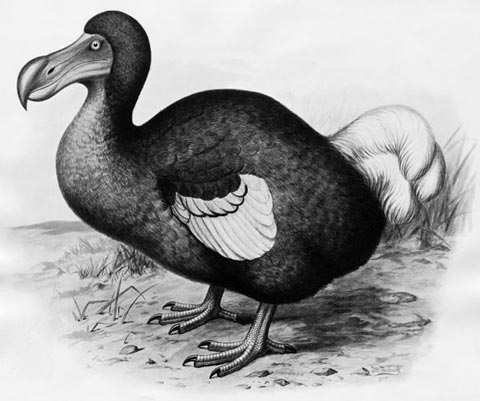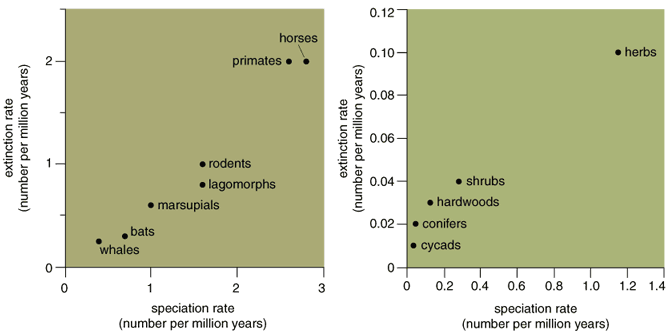The Real Biodiversity Crisis
By Phillip Levin, Donald Levin
What sorts of creatures will survive the current spasm of extinction?
What sorts of creatures will survive the current spasm of extinction?

DOI: 10.1511/2002.13.6
The numbers are grim: Some 2,000 species of Pacific Island birds (about 15 percent of the world total) have gone extinct since human colonization. Roughly 20 of the 297 known mussel and clam species and 40 of about 950 fishes have perished in North America in the past century. On average, one extinction happens somewhere on earth every 20 minutes. Ecologists estimate that half of all living bird and mammal species will be gone within 200 or 300 years. Although crude and occasionally controversial, such statistics illustrate the extent of the current upheaval, which spans the globe and affects a broad array of plants and animals.

Bettman/Corbis
Species extinctions are, of course, perfectly natural. In the grand drama of geologic time, paleontologists have seen countless species enter and exit the stage. All species begin in some restricted setting and then spread. Most subsequently undergo differentiation, and eventually all species come to an end. The diversity of species at any point in time is simply the result of these ongoing processes, which can wax and wane in intensity. For the most part, the total number of species inhabiting the Earth probably remains fairly static.
The current losses are, however, exceptional. Rates of extinction appear now to be 100 to 1,000 times greater than background levels, qualifying the present as an era of "mass extinction." The globe has experienced similar waves of destruction just five times in the past. Devastating as they were, after each of these mass extinctions, biological diversity ultimately recovered. The time it took varied among taxonomic groups and also depended on just where the organisms lived. General recovery probably required a few million years in each case. Taking an optimistic view and assuming people will be around for a few million years yet, we wanted to explore what our descendants' world might be like.
Some ecologists believe that species diversity will not rebound significantly as the natural environment becomes permanently impoverished. Vast tracts of wilderness, for example, may vanish from the earth in the not-so-distant future. If ecological diversity is lost in this way, some conservation biologists argue, speciation rates will be lowered permanently. And because species diversity represents a dynamic equilibrium between extinction and speciation, a lowered rate of speciation would undoubtedly create a lower equilibrium in species number. Thus some foresee a persistent speciation crisis and a plummeting number of species as the main threat to biodiversity in the long term.
Although this argument may hold for, say, the bigger mammals, which presumably require large areas for speciation, it is unlikely to apply to the many terrestrial organisms that are immobile or have small home ranges—in particular, plants and many invertebrates. Indeed, there is ample reason to believe that such life forms may not suffer in the long run. After all, fragmentation of their currently broad, continuous ranges may actually promote speciation rather than retard it. How so? Breaking up habitats will create populations that are isolated from one another, reducing the level of gene flow. Further, population sizes will be reduced, quickening the pace of genetic drift. The combination of these two effects provides an ideal template for speciation.
Species numbers may ultimately rebound for a second reason as well: because the disturbances people produce need not always decrease ecological diversity. In many cases, human actions may merely alter the character of habitats rather than eliminate them. That process might, in fact, foster speciation.
The study of island biogeography offers considerable support for this notion. Islands tend to have depauperate biota relative to continents, so ecological opportunity and thus rates of speciation are higher on islands than on continents. This has been seen for Hawaiian plants in the silversword family, for finches, for honeycreepers, for sparrows and for fruit flies. The link between rates of speciation and ecological opportunity is also apparent when one compares younger islands with older islands in the same archipelago. Older islands have more species than younger ones and so may offer less ecological opportunity. Consequently, speciation rates for older islands are lower than for younger ones. This relation has been clearly demonstrated for Hawaiian plants: Speciation rates on the youngest island in the chain, the big island of Hawaii, are 10 times greater than on the oldest island, Kauai.
Just as with the emergence of a new volcanic island from the sea, episodes of mass extinction offer particularly rich opportunities for the surviving groups. For example, the mass extinction at the end of the Cretaceous (65 million years ago) brought an end to the dinosaurs, but a massive diversification of mammals took place soon afterward. Similarly, with the dramatic decline of marine eurypterids (large arthropods) about 410 million years ago, the first large marine predators were lost. However, they were later surpassed in this role by certain fish, notably the placoderms, a highly diverse group that sported interlocking plates of armor. The placoderms underwent a spectacular radiation during the Devonian (between 410 and 360 million years ago), but at the end of this period all placoderms—large, small, marine and freshwater—went extinct. They were replaced by the actinopterygians (ray-finned fishes), which ultimately produced the teleosts, the dominant group of modern fish.
There is no reason to assume that basic evolutionary processes in the future will differ substantially from those in the past. So we would expect the total number of species ultimately to recover from the current mass extinction, even if people continue to meddle with the environment on a global scale. The alteration and fragmentation of existing habitats ensures that any future radiation of mammals, for instance, will not include large forms such as rhinoceroses, apes and big cats. But other species may do quite well.

Consider the differences in future prospects for primates and rodents. Primates have both high rates of speciation and high rates of extinction. Human activities will likely increase their rates of extinction but may well reduce their opportunities for speciation. In contrast, people may only marginally increase the rates of extinction for rodents, while perhaps promoting their speciation somewhat. The rate of speciation for rodents currently exceeds their rate of extinction by far. Thus, the future may bring a decline in primate variety and an increase in the kinds of rodents roaming about.
Such shifts could be even more dramatic at higher taxonomic levels. Groups with short generation times, small home ranges and great dispersal capabilities—many insects, for example—will clearly be at an evolutionary advantage in a world full of human disturbance and unstable, patchy habitats. (Interestingly, in the mass extinction at the end of the Cretaceous, there is no evidence of any major change in insect faunas.)
So people's activities today affect more than just the tally of species that may go extinct soon: Our actions will also influence the diversity of species that can evolve and persist for millions of years to come. Conservation efforts, therefore, should aim to do more than stem the near-term loss of species. Resources should be directed to ensuring that there will be a rebound in the diversity of plant and animal species, not just in their numbers.
How might one do that? One response to the current crisis is the preservation of biodiversity "hotspots," areas with exceptionally large numbers of endemic species. But a narrow focus on saving the greatest number of species possible risks losing important biological attributes. To minimize this problem, higher-level taxa, such as families, should be used in defining biodiversity hotspots and setting conservation priorities.
Consider, for example, tropical plants. Ghillean Prance at the Royal Botanical Gardens, Kew, has noted that Malesia—the tropical region running from peninsular Malaysia to Papua New Guinea and the Solomon Islands—contains fewer plant species but more plant families than the entire neotropics. Because the number of families probably provides a better measure of the diversity of characteristics and evolutionary potential than does the number of species, preserving the flora of Malesia should be of considerable concern to conservationists interested in maintaining a high degree of biodiversity over the long haul.
After the current spasm of extinction ends, the number of species may well return to past levels, but there will surely be fewer higher-level taxonomic groups than today. Such a wholesale shift in earth's biota will impoverish the planet for many millions of years to come. In our view, this is the real threat to biodiversity—not a decline in species per se, but a long-term erosion in the variety of biological characteristics and functions that grace the natural world.
Click "American Scientist" to access home page
American Scientist Comments and Discussion
To discuss our articles or comment on them, please share them and tag American Scientist on social media platforms. Here are links to our profiles on Twitter, Facebook, and LinkedIn.
If we re-share your post, we will moderate comments/discussion following our comments policy.